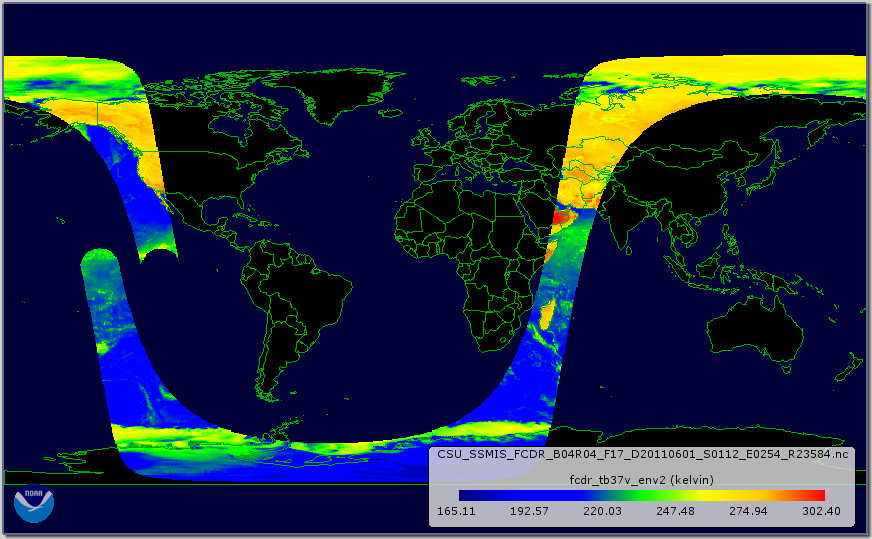NOAA Climate Data Record (CDR) of SSMI(S) and AMSR2 Microwave Brightness Temperatures, CSU Version 2
SSMI(S) Brightness Temperature - CSU
This NOAA Fundamental Climate Data Record (FCDR) from Colorado State University (CSU) contains brightness temperatures that have been improved and quality-controlled over the observational time period. The temperature data are from the Special Sensor Microwave Imager (SSM/I) and Special Sensor Microwave Imager Sounder (SSMIS) series of passive microwave radiometers carried onboard the Defense Meteorological Satellite Program (DMSP) satellites, and from the Advanced Microwave Scanning Radiometer 2 (AMSR2) carried onboard the Global Change Observation Mission 1st - Water (GCOM-W1) satellite. The dataset encompasses data from a total of 11 satellites including the SSM/I sensors on board DMSP satellites F08, F10, F11, F13, F14, and F15, the SSMIS sensors on board DMSP satellites F16, F17, F18, and F19, as well as AMSR2 on board GCOM-W1. The DMSP satellites F09 and F12 were not used. The data record covers the time period from July 1987 beginning with SSM/I through the present with a 7 to 10 day latency. There are roughly 15 orbits per satellite per day with a swath width of approximately 1400 km resulting in nearly global daily coverage. The spatial and temporal resolutions of the FCDR files correspond to the original resolution of the source Temperature Data Record (TDR) observations. The spatial resolution of the data is a function of the sensor/channel and varies from approximately ~50 km for the lowest frequency channels to ~15km for the high-frequency channels. The output parameters include the observed brightness temperatures for each channel at the original sensor channel resolution along with latitude and longitude for each pixel, time, quality flags, and view angle information. Interim updates to the FCDR, notated as ICDR, are produced on an operational basis as new source data become available. The initially-produced interim files or ICDR files are produced prior to the final FCDR production. Once the data has been fully checked, updates for the final FCDR files are provided approximately every year. There are several changes to Version 2 from Version 1 of the FCDR. 1) The addition of inter-calibrated data from the GCOM-W1 AMSR2 instrument for the period from July 2, 2012 to the present. 2) A change from relative inter calibration to SSM/I on board DMSP F13 to an absolute calibration based on the well-documented and published calibration of the GPM GMI instrument. 3) Multiple updates to geolocation and calibration corrections to the SSM/I and SSMIS brightness temperature data including improved geolocation and pointing information, updated cross-track bias corrections, updated corrections for solar intrusions, and updated inter calibration adjustments incorporating corrections over both cold and warm scenes. The file format is netCDF-4 with added metadata that follow the Climate and Forecast (CF) Conventions and Attribute Convention for Dataset Discovery (ACDD).
- Cite as: Kummerow, Christian D., Wesley K. Berg, Chia-Pang Kuo, and NOAA CDR Program (2022): NOAA Climate Data Record (CDR) of SSMI(S) and AMSR2 Microwave Brightness Temperatures, CSU Version 2. [indicate subset used]. NOAA National Centers for Environmental Information. https://doi.org/10.25921/E3K5-BW77. [access date].
- doi:10.25921/E3K5-BW77
- NCEI DSI 3610_02
- gov.noaa.ncdc:C01653
C01653
| Download Data |
|
| Distribution Formats |
|
| Ordering Instructions | Contact NCEI for other distribution options and instructions. |
| Distributor | NOAA National Centers for Environmental Information
ncei.info@noaa.gov |
| Dataset Point of Contact | NOAA Climate Data Record Program Office
DOC/NOAA/NESDIS/NCEI > National Centers for Environmental Information, NESDIS, NOAA, U.S. Department of Commerce +1 (828) 271-4800 csu_ssmis_contacts@noaa.gov |
| Coverage Description | |
| Time Period | 1987-07-09 to Present |
| Spatial Bounding Box Coordinates |
N: 90.0
S: -90.0
E: 180.0
W: -180.0
|
| Spatial Coverage Map | |
| General Documentation |
|
| Processing Documents |
|
| Publication Dates |
|
| Edition | Version 2 |
| Data Presentation Form | Digital image
|
| Dataset Progress Status | Ongoing - data is continually being updated |
| Data Update Frequency | Daily |
| Purpose | This dataset provides advanced scientific researchers a high quality Climate Data Record (CDR) of microwave brightness temperatures. This FCDR dataset provides input into a number of Thematic CDR (TCDR) products including precipitation, sea surface wind speed, sea ice extent, snow cover, cloud liquid water, and total precipitable water content. |
| Use Limitations |
|
| Dataset Citation |
|
| Cited Authors |
|
| Principal Investigators |
|
| Collaborators |
|
| Publishers |
|
| Theme keywords | Global Change Master Directory (GCMD) Science Keywords
|
| Data Center keywords | Global Change Master Directory (GCMD) Data Center Keywords
|
| Platform keywords | Global Change Master Directory (GCMD) Platform Keywords
|
| Instrument keywords | Global Change Master Directory (GCMD) Instrument Keywords
|
| Place keywords | Global Change Master Directory (GCMD) Location Keywords
|
| Project keywords | Keyword Thesaurus Title
|
| Data Resolution keywords | Global Change Master Directory (GCMD) Horizontal Data Resolution Keywords
|
| Use Constraints |
|
| Access Constraints |
|
| Fees |
|
| Processing Steps |
|
Last Modified: 2023-08-10
For questions about the information on this page, please email: ncei.info@noaa.gov
